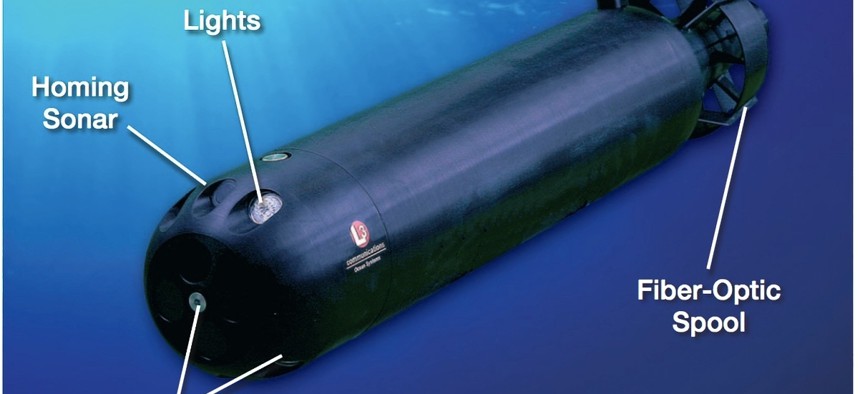
L3’s Remora autonomous underwater vehicle. L3 Technologies
L3 Shops for a Shipyard — and a Place in the Defense Industry’s Top Tier
Its bullish new CEO wants America’s sixth-largest defense firm viewed in the same group as the Big 5.
L3 Technologies is eying a shipyard as the company deepens its push into the underwater drone market and beyond, Defense One has learned.
The move comes as new CEO Christopher Kubasik looks to grow America’s sixth-largest defense company. While Kubasik tiptoed around a question about an expansion into shipbuilding on the company’s quarterly earnings call Tuesday, he made several bullish comments about plans for more acquisitions and growing the firm’s infrastructure.
“Everything is on the table,” Kubasik said. “If it makes sense, we’ll pursue it.”
L3 spent more than $300 million on acquisitions in 2017, and expects to top that in 2018, Kubasik said.
The company “can easily make $1 billion of acquisitions a year,” he said. “We’ll be happy to do larger acquisitions if they make sense strategically and operationally and financially.”
L3 is about to be flush with cash. On Tuesday, company officials announced a $540 million sale of its Vertex services business, plus aerospace units Crestview Aerospace and TCS, to a private equity firm. Kubasik said he expects the deal, which will close this summer, to generate $400 million after-tax to be “put to use based on our strategic priorities.”
L3’s shipyard search was the buzz among at last month’s Navy League Sea-Air-Space conference — the largest maritime trade show in the U.S., held annually in a Washington, D.C., suburb.
New York-based L3 has been scooping up companies that specialize in autonomous underwater drone technology. At Sea-Air-Space, it showed off its Iver Precision Workhorse, an autonomous undersea vehicle. A company statement called the sub “the first in a family of advanced, highly capable military AUVs to address a wide variety of customer missions, including multi-domain intelligence, surveillance and reconnaissance, anti-submarine warfare, seabed warfare and mine warfare.” The drone is made by OceanServer, which L3 acquired last year. The U.S. Navy alone is expected to invest $3 billion in undersea technology, the Washington Post reported in 2016.
“The No. 1 way to improve margins in my opinion has always been to increase the denominator and to grow,” Kubasik said Tuesday on the earnings call. “I think volume is the best way to improve your profitability and that’s why we’ve rolled out our disciplined growth strategy and myself and my team and others have been aggressively out there meeting with customers both as a supplier to the primes and directly to the end uses to try to jumpstart the growth.”
Kubasik wants his company, which had 2017 defense revenues of $8.9 billion, viewed alongside the “Big 5”: Lockheed Martin ($43.7 billion), Boeing, Raytheon, Northrop Grumman and General Dynamics ($19.7 billion).
“Our ultimate goal is to have the scale and capabilities to compete for programs as a non-traditional, sixth price [contractor],” he said.
L3 is amid a leadership transition. Kubasik took over as CEO in January, but his predecessor, Michael Strianese, remained chairman. Kubasik is poised to become chairman following a vote at a shareholders meeting next Monday.
In another sign of its push deeper into the naval market, L3 in January appointed Sean Stackley as corporate vice president of strategic advanced programs and technology. Stackley oversaw the Navy’s acquisition portfolio for more than nine years, and served as acting Navy secretary for more than half of 2017.
“I think by the end of the calendar year we’ll have the entire team in place and ready to go,” Kubasik said of changes within the firm’s leadership.




